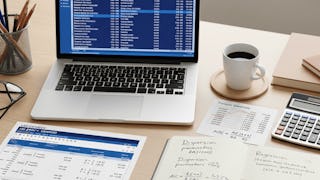This introductory course is for SAS software users who perform statistical analyses using SAS/STAT software. The focus is on t tests, ANOVA, and linear regression, and includes a brief introduction to logistic regression.

Enjoy unlimited growth with a year of Coursera Plus for $199 (regularly $399). Save now.

(300 reviews)
Skills you'll gain
Details to know

Add to your LinkedIn profile
61 assignments
See how employees at top companies are mastering in-demand skills

There are 8 modules in this course
In this module you learn about the course and the data you analyze in this course. Then you set up the data you need to do the practices in the course.
What's included
2 videos5 readings
In this module you learn about the models required to analyze different types of data and the difference between explanatory vs predictive modeling. Then you review fundamental statistical concepts, such as the sampling distribution of a mean, hypothesis testing, p-values, and confidence intervals. After reviewing these concepts, you apply one-sample and two-sample t tests to data to confirm or reject preconceived hypotheses.
What's included
17 videos2 readings9 assignments
In this module you learn to use graphical tools that can help determine which predictors are likely or unlikely to be useful. Then you learn to augment these graphical explorations with correlation analyses that describe linear relationships between potential predictors and our response variable. After you determine potential predictors, tools like ANOVA and regression help you assess the quality of the relationship between the response and predictors.
What's included
29 videos2 readings14 assignments
In this module you expand the one-way ANOVA model to a two-factor analysis of variance and then extend simple linear regression to multiple regression with two predictors. After you understand the concepts of two-way ANOVA and multiple linear regression with two predictors, you'll have the skills to fit and interpret models with many variables.
What's included
13 videos1 reading5 assignments
In this module you explore several tools for model selection. These tools help limit the number of candidate models so that you can choose an appropriate model that's based on your expertise and research priorities.
What's included
11 videos3 readings4 assignments
In this module you learn to verify the assumptions of the model and diagnose problems that you encounter in linear regression. You learn to examine residuals, identify outliers that are numerically distant from the bulk of the data, and identify influential observations that unduly affect the regression model. Finally, you learn to diagnose collinearity to avoid inflated standard errors and parameter instability in the model.
What's included
18 videos7 assignments
In this module you learn how to transition from inferential statistics to predictive modeling. Instead of using p-values, you learn about assessing models using honest assessment. After you choose the best performing model, you learn about ways to deploy the model to predict new data.
What's included
11 videos1 reading4 assignments
In this module you look for associations between predictors and a binary response using hypothesis tests. Then you build a logistic regression model and learn about how to characterize the relationship between the response and predictors. Finally, you learn how to use logistic regression to build a model, or classifier, to predict unknown cases.
What's included
25 videos18 assignments
Instructor

Offered by
Explore more from Data Analysis
 Status: Free Trial
Status: Free Trial Status: Free Trial
Status: Free Trial Status: Preview
Status: Preview
Why people choose Coursera for their career




Learner reviews
300 reviews
- 5 stars
83%
- 4 stars
12.33%
- 3 stars
2.33%
- 2 stars
0.66%
- 1 star
1.66%
Showing 3 of 300
Reviewed on Apr 10, 2022
Very professional and useful course. I like it. The level of difficulty is very balanced, neither easy nor very hard.
Reviewed on Oct 28, 2019
best course to learn n rewind concepts. helped me at lot for my placement preparations
Reviewed on Jun 24, 2020
A good course that helped me with SAS coding and commands.

Open new doors with Coursera Plus
Unlimited access to 10,000+ world-class courses, hands-on projects, and job-ready certificate programs - all included in your subscription
Advance your career with an online degree
Earn a degree from world-class universities - 100% online
Join over 3,400 global companies that choose Coursera for Business
Upskill your employees to excel in the digital economy
Frequently asked questions
To access the course materials, assignments and to earn a Certificate, you will need to purchase the Certificate experience when you enroll in a course. You can try a Free Trial instead, or apply for Financial Aid. The course may offer 'Full Course, No Certificate' instead. This option lets you see all course materials, submit required assessments, and get a final grade. This also means that you will not be able to purchase a Certificate experience.
When you purchase a Certificate you get access to all course materials, including graded assignments. Upon completing the course, your electronic Certificate will be added to your Accomplishments page - from there, you can print your Certificate or add it to your LinkedIn profile.
Yes. In select learning programs, you can apply for financial aid or a scholarship if you can’t afford the enrollment fee. If fin aid or scholarship is available for your learning program selection, you’ll find a link to apply on the description page.
More questions
Financial aid available,


